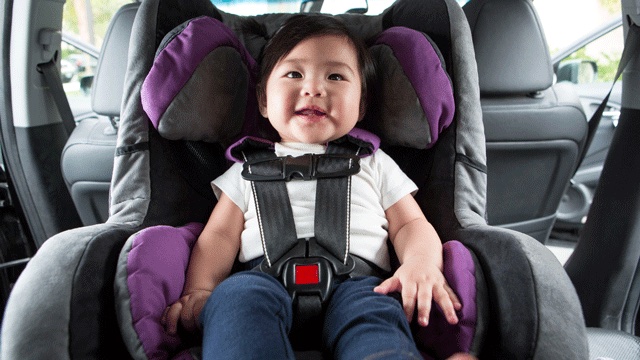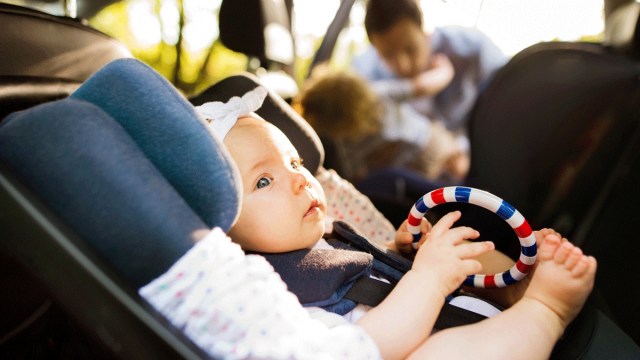Does your baby break out into a cold sweat every time you’re in the car for more than a few minutes? Do you have a toddler who can’t get through a long drive without vomiting? Blame motion sickness. According to the Mayo Clinic, while car sickness is rare (but not impossible) for children under two, it is especially common for kids ages two to 12, with symptoms including nausea, pallor, and sweating.
“Motion sickness can occur in toddlers and infants. That does not mean there is any cause for alarm,” said American Academy of Pediatrics (AAP) spokesperson Lauren Crosby, a Beverly Hills pediatrician. “It is not a cause for concern. Just not fun to feel or deal with.”
So what can you do to help prevent motion sickness for kids on your next family road trip? Here’s everything you need to know about carsickness in babies and toddlers: Why it happens, how to spot the symptoms, and what you can do to help.
Carsickness: Why It Happens
Experts aren’t sure why some people get super carsick while others don’t feel a thing. But they do agree that the sensation is caused when the brain receives mixed signals from the motion-sensing parts of the body. Basically, if your body is sitting still, but your eyes and inner ears sense movement around you, that disconnect can cause dizziness and nausea.
Kids are particularly sensitive to motion sickness in cars because they’re usually sitting so low that while their inner ears sense motion, their eyes don’t always see it (especially if they’re looking at a book or device). That disconnect creates the familiar symptoms of carsickness—mainly dizziness, fatigue, headaches, and nausea.
It can also be genetic. That means, if you’re prone to feeling yucky in cars, there’s a 50 percent chance your child will inherit the condition from you. According to the American Academy of Pediatrics, the condition usually crops up in the late toddler years (2 and up) and continues through childhood, peaking around age 9 or 10. Infants don’t usually suffer from motion sickness since their brains haven’t yet figured out exactly what “normal” movement should feel like, said the AAP. But that doesn’t mean they’re immune.
“For infants, the issue is complicated by 1) the fact that you cannot ask them and 2) the fact that they often throw up, anyway, so we cannot know for sure why an infant throws up on any particular occasion,” Tom Stoffregen, a professor of kinesiology at the University of Minnesota, said in an e-mail. “My educated guess is that infants have a low risk of motion sickness because they have low ‘goals’ for bodily stability.”

Symptoms of Motion Sickness in Babies & Toddlers
Babies and young toddlers can’t tell you in words that they’re feeling dizzy or nauseous from the twists and turns of the road. But they’ll let you know in other ways. Some symptoms of motion sickness in kids to look out for include:
- Sudden change in mood (they become grumpy or cry more than usual)
- Frequent yawning (even after a nap)
- Cold sweat or pale face
- Loss of appetite
- Restlessness
- Increased saliva
- Vomiting
- Older kids may have any or all of these symptoms and may also complain of an upset stomach, headaches, or dizziness
Tips to Prevent Carsickness in Children
The best way to stop carsickness is to try to prevent it from happening in the first place. Here are some things that can help your kids from getting queasy:
1. Don’t overfeed—or underfeed—your child before a long drive
A very full—or very hungry—tummy may make carsickness worse (and your car messier, should all that food come back up). Give your baby or toddler a small meal or light snack before a long car trip. Stick with easy-to-digest foods like crackers, oatmeal, or pureed fruits and vegetables (breast milk or formula is fine, too). And while it’s tempting to swing by the fast food drive-through for some deep-fried munchies—resist! High-fat or greasy foods can make nausea worse.
2. Put forward-facing kids (over 2) in the middle seat so they can see the horizon out the front windshield
Sitting in the middle seat can be helpful in alleviating carsickness since it offers a straight-shot view of the road (and horizon) ahead. This can help kids maintain some equilibrium.
Note: The American Academy of Pediatrics recommends leaving children in rear-facing car seats until at least 2 years old or when they reach the highest weight or height allowed by their car safety seat manufacturer.
3. Don’t let your child read or use an iPad during a car trip
Sorry—we know the devices keep those “Are we there yets” to a minimum—but reading or even looking down (as opposed to out the window or at the horizon) makes carsickness worse. Instead, engage your troubled travelers with things like audiobooks, songs, and music, and encourage them to look out the window.
4. Make sure there’s good airflow in the car
Keeping the windows open or the air vents flowing in the car can help, experts say, since stuffy (potentially stinky) air may make nausea worse. Similarly, don’t bring any foods that have strong odors.
5. Plan the trip for naptime
A sleeping child is less likely to be a carsick one. Plan the trip for when your child usually naps—or at night—so that she’ll snooze the trip away before she has the chance to feel woozy.
6. Prepare for the worst
Bring wipes, paper towels, a change of clothes, Ziploc bags, and a towel to cover the car seat (and the area around it) if you anticipate carsickness.
Related: Unplugged Road Trips with Toddlers: Your How-To Guide

How to Treat Carsickness in Babies and Toddlers
So what if you’ve taken all the steps to prevent your kids from getting motion sickness, and you still end up with a carsick kiddo?
Stop driving
Frequent stops may add hours to your journey, but it can help keep queasy feelings to a minimum.
Take Your Child Outside
When you stop, let your child get some fresh air. Letting her lie on her back with a cold washcloth on her forehead can help the symptoms pass more quickly, according to Stanford Health.
Offer cold water or light snacks
If your child has vomited, wait until nausea passes and then have them take sips of cold water (or breast milk if your baby is still nursing). A small, light snack can help as well.
Children over two can take over-the-counter motion sickness meds
Talk to your doctor about whether taking over-the-counter medications like Dramamine or antihistamines (which work in the same way) can help your child. Keep in mind that these meds cause drowsiness and have other possible side effects, including dry mouth and blurred vision, so weigh the benefits and risks carefully.
Please Note: Don’t give any medications to your child (even over-the-counter meds) without asking you doctor first.
Be wary of alternative treatments
Crosby warned against using “alternative” seasickness treatments such as ginger chews, essential oils, and acupressure bands for infants and toddlers since most of those are meant for adults or older children. Seasick bands, in particular, can be a choking hazard to children under 3.
How to Know When It’s More Than Motion Sickness
Carsickness usually gets better when the motion ceases, so if your child continues to feel sick even a half hour after getting out of the car, it could be a stomach bug or something she ate. On the contrary, if your child vomits or cries incessantly every time you set out on a road trip (or even a long ride to daycare), the motion may be to blame.
“The key in telling the difference between motion sickness and something else has to do with monitoring symptoms over time, so if every time a child rides in the car they throw up or get unusually fussy, restless, pale, sweaty, then likely that is motion sickness,” Crosby said. “If the vomiting happens once but never again, then it likely was something else, like the start of a stomach virus.”
Good to Know: If your child feels “carsick,” even when not in motion—especially if this feeling is accompanied by a headache, difficulty hearing, seeing, walking, or talking—contact your doctor, as these can be symptoms of something more serious.
The Good News
According to experts, carsickness usually declines with age, with children ages 6 to 12 years old being the most susceptible. “Motion sickness varies across the lifespan,” said Stoffregen, who has studied motion sickness in people of all ages for almost 35 years. “Things that made us sick when we were kids may no longer make us sick as adults, and vice versa.”
And, for you parents who have suffered with the ailment all your lives, hang in there. According to the Centers for Disease Control and Prevention, the condition usually gets better after about age 50.
Until then… drive safe!











